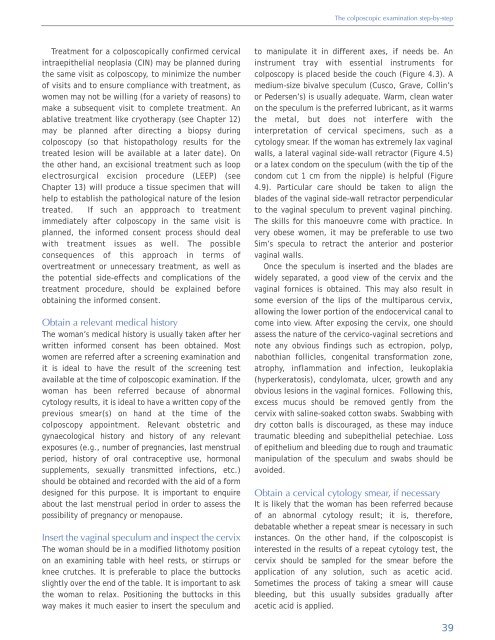Colposcopy and Treatment of Cervical Intraepithelial Neoplasia - RHO
Colposcopy and Treatment of Cervical Intraepithelial Neoplasia - RHO
Colposcopy and Treatment of Cervical Intraepithelial Neoplasia - RHO
Create successful ePaper yourself
Turn your PDF publications into a flip-book with our unique Google optimized e-Paper software.
The colposcopic examination step-by-step<br />
<strong>Treatment</strong> for a colposcopically confirmed cervical<br />
intraepithelial neoplasia (CIN) may be planned during<br />
the same visit as colposcopy, to minimize the number<br />
<strong>of</strong> visits <strong>and</strong> to ensure compliance with treatment, as<br />
women may not be willing (for a variety <strong>of</strong> reasons) to<br />
make a subsequent visit to complete treatment. An<br />
ablative treatment like cryotherapy (see Chapter 12)<br />
may be planned after directing a biopsy during<br />
colposcopy (so that histopathology results for the<br />
treated lesion will be available at a later date). On<br />
the other h<strong>and</strong>, an excisional treatment such as loop<br />
electrosurgical excision procedure (LEEP) (see<br />
Chapter 13) will produce a tissue specimen that will<br />
help to establish the pathological nature <strong>of</strong> the lesion<br />
treated. If such an appproach to treatment<br />
immediately after colposcopy in the same visit is<br />
planned, the informed consent process should deal<br />
with treatment issues as well. The possible<br />
consequences <strong>of</strong> this approach in terms <strong>of</strong><br />
overtreatment or unnecessary treatment, as well as<br />
the potential side-effects <strong>and</strong> complications <strong>of</strong> the<br />
treatment procedure, should be explained before<br />
obtaining the informed consent.<br />
Obtain a relevant medical history<br />
The woman’s medical history is usually taken after her<br />
written informed consent has been obtained. Most<br />
women are referred after a screening examination <strong>and</strong><br />
it is ideal to have the result <strong>of</strong> the screening test<br />
available at the time <strong>of</strong> colposcopic examination. If the<br />
woman has been referred because <strong>of</strong> abnormal<br />
cytology results, it is ideal to have a written copy <strong>of</strong> the<br />
previous smear(s) on h<strong>and</strong> at the time <strong>of</strong> the<br />
colposcopy appointment. Relevant obstetric <strong>and</strong><br />
gynaecological history <strong>and</strong> history <strong>of</strong> any relevant<br />
exposures (e.g., number <strong>of</strong> pregnancies, last menstrual<br />
period, history <strong>of</strong> oral contraceptive use, hormonal<br />
supplements, sexually transmitted infections, etc.)<br />
should be obtained <strong>and</strong> recorded with the aid <strong>of</strong> a form<br />
designed for this purpose. It is important to enquire<br />
about the last menstrual period in order to assess the<br />
possibility <strong>of</strong> pregnancy or menopause.<br />
Insert the vaginal speculum <strong>and</strong> inspect the cervix<br />
The woman should be in a modified lithotomy position<br />
on an examining table with heel rests, or stirrups or<br />
knee crutches. It is preferable to place the buttocks<br />
slightly over the end <strong>of</strong> the table. It is important to ask<br />
the woman to relax. Positioning the buttocks in this<br />
way makes it much easier to insert the speculum <strong>and</strong><br />
to manipulate it in different axes, if needs be. An<br />
instrument tray with essential instruments for<br />
colposcopy is placed beside the couch (Figure 4.3). A<br />
medium-size bivalve speculum (Cusco, Grave, Collin’s<br />
or Pedersen’s) is usually adequate. Warm, clean water<br />
on the speculum is the preferred lubricant, as it warms<br />
the metal, but does not interfere with the<br />
interpretation <strong>of</strong> cervical specimens, such as a<br />
cytology smear. If the woman has extremely lax vaginal<br />
walls, a lateral vaginal side-wall retractor (Figure 4.5)<br />
or a latex condom on the speculum (with the tip <strong>of</strong> the<br />
condom cut 1 cm from the nipple) is helpful (Figure<br />
4.9). Particular care should be taken to align the<br />
blades <strong>of</strong> the vaginal side-wall retractor perpendicular<br />
to the vaginal speculum to prevent vaginal pinching.<br />
The skills for this manoeuvre come with practice. In<br />
very obese women, it may be preferable to use two<br />
Sim’s specula to retract the anterior <strong>and</strong> posterior<br />
vaginal walls.<br />
Once the speculum is inserted <strong>and</strong> the blades are<br />
widely separated, a good view <strong>of</strong> the cervix <strong>and</strong> the<br />
vaginal fornices is obtained. This may also result in<br />
some eversion <strong>of</strong> the lips <strong>of</strong> the multiparous cervix,<br />
allowing the lower portion <strong>of</strong> the endocervical canal to<br />
come into view. After exposing the cervix, one should<br />
assess the nature <strong>of</strong> the cervico-vaginal secretions <strong>and</strong><br />
note any obvious findings such as ectropion, polyp,<br />
nabothian follicles, congenital transformation zone,<br />
atrophy, inflammation <strong>and</strong> infection, leukoplakia<br />
(hyperkeratosis), condylomata, ulcer, growth <strong>and</strong> any<br />
obvious lesions in the vaginal fornices. Following this,<br />
excess mucus should be removed gently from the<br />
cervix with saline-soaked cotton swabs. Swabbing with<br />
dry cotton balls is discouraged, as these may induce<br />
traumatic bleeding <strong>and</strong> subepithelial petechiae. Loss<br />
<strong>of</strong> epithelium <strong>and</strong> bleeding due to rough <strong>and</strong> traumatic<br />
manipulation <strong>of</strong> the speculum <strong>and</strong> swabs should be<br />
avoided.<br />
Obtain a cervical cytology smear, if necessary<br />
It is likely that the woman has been referred because<br />
<strong>of</strong> an abnormal cytology result; it is, therefore,<br />
debatable whether a repeat smear is necessary in such<br />
instances. On the other h<strong>and</strong>, if the colposcopist is<br />
interested in the results <strong>of</strong> a repeat cytology test, the<br />
cervix should be sampled for the smear before the<br />
application <strong>of</strong> any solution, such as acetic acid.<br />
Sometimes the process <strong>of</strong> taking a smear will cause<br />
bleeding, but this usually subsides gradually after<br />
acetic acid is applied.<br />
39
















